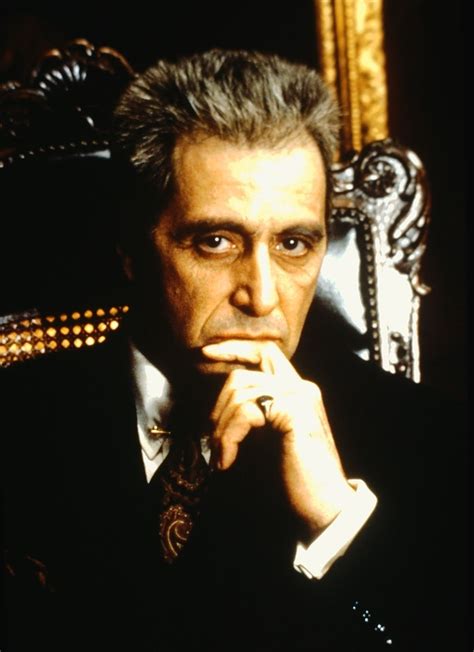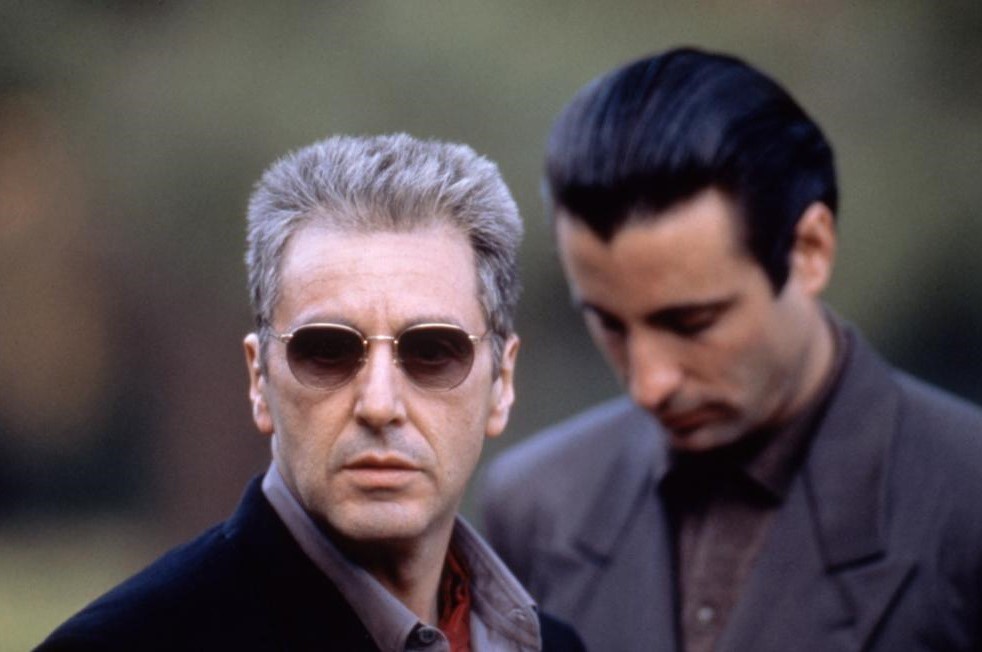The Godfather Part III (1990)

DIRECTOR: Francis Ford Coppola
CAST: Al Pacino, Andy Garcia, Talia Shire, Diane Keaton, Sofia Coppola, Eli Wallach, Joe Mantegna, Bridget Fonda, George Hamilton
REVIEW:
The Godfather Part III is an example of the difficulties inherent in releasing a sequel to an acclaimed film series after so much time has elapsed. The 1972 original and its 1974 follow-up are rightfully regarded as one of the greatest one-two punches in cinematic history, with Part III considered a bit of a tired-out afterthought; indicative of the general lack of enthusiasm, it was the first Godfather movie not to win Best Picture, and the first for which Al Pacino did not receive an Oscar nomination. The Godfather Part III is not as bad of a movie as it’s often derided as; in fact, it’s a good one, with some tremendous moments, but it’s not a great one, and for the Godfather franchise, that’s just not quite good enough.
It’s 1979, twenty years since the events of The Godfather Part II. The aging Michael Corleone (Al Pacino) has relocated his family back to New York City, where he has handed over the remnants of the criminal enterprise to others and severed all direct gangland ties. The Corleone family, at least in its direct holdings and activities, is finally legitimate, and the now “respectable” Michael is honored by the Vatican with high honors for a $100 million donation by his charitable foundation. But Michael is a weary and troubled man, weighed down by the years and haunted by his past misdeeds, especially ordering the murder of his own brother Fredo. The light in his life is his beloved daughter Mary (Sofia Coppola), chairwoman of his charity foundation and to whom he wants to leave his empire; his son Anthony (Franc D’Ambrosio), by contrast, wants nothing to do with him or the family business and wants to be an opera singer. But disentangling himself from his old gangster ties will be easier said than done, as a series of complications crop up. First is Vincent Mancini (Andy Garcia), the hotheaded illegitimate son of Michael’s long-dead brother Sonny, who has inherited his father’s instinct to shoot first and ask questions later, and is embroiled in a conflict with Joey Zasa (Joe Mantegna), to whom Michael has left control of the former Corleone criminal empire. Michael takes Vincent under his wing, trying to impart some wisdom, and it might be a good time to find a protege. Michael is drawn into a business deal with the Vatican Bank, but when he makes a $600 million play for control of the international conglomerate Immobiliare, his old Mafioso allies want a piece of the action, and Michael’s refusal at a mob conference makes him enemies again.
One of the most obvious problems with The Godfather Part III is that it covers little new territory and it’s hard to deny that the creative team feels a little tired and played-out. The plot is also convoluted, mixing in Vatican scandals, corporate power plays, venal cardinals, etc. It’s been claimed that Coppola and Mario Puzo were basically making it up as they went along, and there’s times when it shows; the movie lacks the elegant plotting of its predecessors and feels sometimes messy and disjointed and like it’s not sure what it’s trying to be about. As before, there’s no real singular main “villain”—Joe Mantegna’s Joey Zasa is set up as an antagonist, but like Al Lettieri’s Sollozzo in the original movie, this is only for the first act—instead serving up a lineup including Zasa, a slimy Archbishop (Donal Donnelly), a Vatican Bank board member (Enzo Robutti), a Swiss banker (Helmut Berger), and Michael’s two-faced “old friend” Don Altobello (Eli Wallach), but their scheming is elaborated on with more screentime than clarity. The first movie had a knack for making even minor side characters distinct individuals; the excess of non-entities wandering around here aren’t up to the same level. One could argue the previous films had convoluted machinations as well, but some of the stuff here, with Michael in business with the Vatican Bank and taking over Immobiliare, doesn’t feel like Godfather material. The further away the movie strays from the traditional old-school Mafioso tropes, the less it feels like a Godfather movie. At the same time, some plot elements are derivative of the original, including the elderly “Godfather” handing over the reins to a more ruthless protege, a Mafia conference, a slick first act villain who is disposed of early (Joey Zasa in place of Sollozzo), a trip to Sicily, and of course the obligatory climactic massacre where the Corleones wipe out all their enemies. There are also superfluous characters, like a scoop-hunting reporter (Bridget Fonda) who’s sleeping with Vincent, and some plot elements are over-obvious; there’s a bit where the villains, falling for a “defection” ruse, welcome the mole into their Villain Meeting in mustache-twirling fashion (just compare this to when Luca Brasi tried the exact same thing with Sollozzo and Bruno Tattaglia in the original movie and was promptly disposed of). The movie plays even faster and looser than its predecessors in intertwining fact and fiction, incorporating real events—the sudden death of Pope John Paul I (here a poisoning), the Vatican Bank’s financial scandals, the body of a Vatican banker found hanging from a London bridge—with the Corleone family saga.
On the plus side, the movie is technically accomplished and stylistically true to form. There are various points where Coppola’s directorial flair is still in effect, never more so than in the climax, where with typical operatic grandeur, he intercuts a massacre of Corleone enemies with Michael attending a performance at an opera house. Cinematographer Gordon Willis returns, again drenching the film in his muted, almost sepia-toned hues, ensuring this at least looks like a Godfather movie. Carmine Coppola has taken over for Nino Rota as composer, though Rota’s classic music is used liberally, so there’s not a conspicuous difference. Al Martino’s Johnny Fontane from the original film makes a small reappearance. The finale builds to an ending which is even more tragic and devastating than each of the progressively bleaker closes of its two predecessors, and ends on a bitterly ironic note.

Al Pacino, sixteen years older and deliberately made up to look older still, plays Michael with a mournful weariness, the weight of the years and his sins hang over him like a dark cloud, manifested in the gauntness of his face and the thick rasp of his voice, but while he’s called Michael Corleone, there’s times when he comes across more as Generic Al Pacino Character than the character from the first two films. Perhaps it’s just the passage of time, but we often feel more like we’re watching Al Pacino being Al Pacino than being Michael Corleone. He’s still restrained (by his standards) for the most part, but there’s a handful of occasions where he slips into some of the histrionics that are hallmarks of his later career and were nowhere to be found in the first two films (like his overplayed diabetic stroke, where he flails around thrashing all over the room and screams his lungs out). Overall, it’s a solid performance in its own right, but it’s iffy how well Pacino slips back into a character he last played sixteen years beforehand. Also feeling a little “off” is Talia Shire’s Connie, who sometime in the past twenty years has turned into a fierce Godmother (?) who sanctions hits in her own right and lurks in the shadowy corners of rooms lobbying for her favorites (Vincent, whom she urges Michael to take under his wing). It doesn’t fit with the previously established characters or their dynamic for Connie to either be so proactively involved in the Corleone family’s criminal activities, nor for Michael to allow her to be, resulting in us not quite feeling like we’re watching the same character. Diane Keaton returns as Michael’s ex-wife Kay, who still holds ambivalent feelings toward him. The biggest newcomer is Andy Garcia, bringing a slick swagger and itchy trigger finger to Michael’s protege Vincent, who’s inherited his father’s temper but in whom Michael tries to instill some of his own more calculating personality traits. Other new faces in smaller roles include Eli Wallach as the outwardly doddering, actually shrewd and scheming Don Altobello, and Bridget Fonda in a small role as Vincent’s superfluous reporter girlfriend. The absence of Robert Duvall is felt (Duvall declined to return after the studio rejected his wish for more salary equality between himself and Pacino); the Corleones’ new lawyer, George Hamilton’s “B.J. Harrison” is a one-dimensional non-entity who exists as a plot device. Also feeling a little lightweight is Joe Mantegna whose slickster Joey Zasa (reportedly loosely modeled after fellow sharp-dressed publicity hound John Gotti) doesn’t quite get us to take him seriously as a mobster. Easily the most glaring weak link, though, is the director’s daughter Sofia Coppola, whom her father cast after his first pick Winona Ryder dropped out, claiming exhaustion. Coppola sticks out like a sore thumb whenever she opens her mouth, evidencing little ability to act her way out of a paper bag, and her wooden line delivery is cringe-inducing at worst, at best lessens the effect of various scenes. This is the first role in the entire Godfather trilogy to be so glaringly poorly-cast or marred by such a conspicuously weak performance. Series veteran Richard Bright, who’s played the Corleone hitman Al Neri in all three installments, is still on-hand, and Al Martino’s Johnny Fontane makes a brief reappearance.
Ultimately, The Godfather Part III brings things full circle to a bleakly befitting conclusion that fulfills Michael Corleone’s arc as near-Shakespearean tragedy, even if it takes a sometimes meandering and disjointed route to get there. Despite its missteps, it packs enough of a punch to be worthy of more acknowledgment than it has often received. Taken as a whole, The Godfather trilogy is one of the most emotionally and thematically rich tales ever to reach the screen, and if there’s some drop-off here, it’s not enough to seriously mar that stature.
* * *